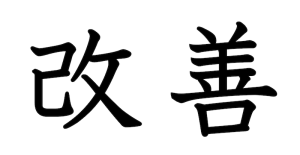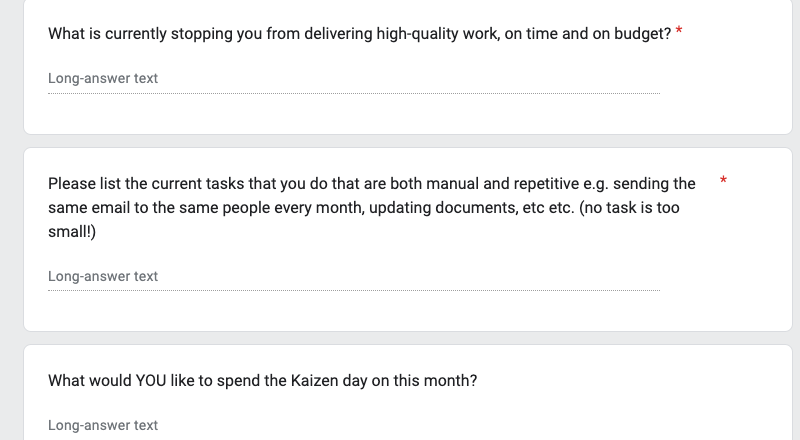
A Kaizen Event (or Kaizen Day) is a key to Japan’s competitive success over traditional western management.
Japanese organisations continuously and mindfully initiate gradual change – a philosophy that we’ve now wholly incorporated into our agency management processes at Digivate.
Kaizen Days have helped us to automate some of the internal agency processes, serve our clients more effectively, and ultimately – innovate in the digital space.
Below we’ll share when and how to use Kaizen Events, as well as go through the steps needed to succeed in continuous organisational improvement.
What is Kaizen Day?
A Kaizen Event (or Kaizen Day) is:
- A structured workshop where a cross-functional team collaborates intensively (usually 1-5 days) to identify and implement improvements in a specific existing process within a company.
- Aims to eliminate waste and enhance efficiency through focused problem-solving.
- “Kaizen” translates from Japanese to “change for the good,” reflecting the continuous improvement philosophy.

The key to Kaizen Culture is continuous improvement, so unlike one-off training and development events, Kaizen Days are a regular occurence.
Kaizen Days must include these 5 elements:
- Teamwork: Kaizen Days are not solo endeavours. Teams with diverse perspectives come together to tackle challenges. This cross-functional collaboration allows everyone to leverage their strengths and identify blind spots. By working together, teams can brainstorm more creative solutions and build a stronger sense of shared purpose.
- Personal discipline: Successful Kaizen Days require focus and commitment from all participants. This means setting aside distractions, actively listening to others’ ideas, and staying engaged throughout the process. Personal discipline ensures that everyone contributes effectively and that the limited time of Kaizen Day is used productively.
- Improved morale: Kaizen Days are designed to be empowering and positive experiences. By actively participating in identifying and implementing improvements, employees feel a sense of ownership over their work environment. Seeing their ideas translated into action boosts morale and fosters a sense of accomplishment within the team.
- Quality circles: Kaizen Days often incorporate the concept of quality circles. These are small, facilitated groups that meet regularly to discuss process improvements within their specific areas of expertise. Quality circles provide a structured platform for focused problem-solving and ensure that everyone has a voice in the improvement process.
- Suggestions for improvement: Kaizen Days are all about encouraging a constant flow of suggestions for improvement. By creating a safe space where everyone feels comfortable sharing their ideas, no matter how small, teams can tap into a wealth of collective knowledge. This open communication is crucial for identifying areas for improvement and fostering a culture of continuous learning.
The Benefits of a Kaizen Day
Kaizen Events offer a powerful combination of benefits that can significantly boost your organisation. Firstly, they deliver rapid results. The focused, intensive nature of the event allows teams to quickly identify and implement improvements, leading to tangible benefits within a short timeframe.
Secondly, Kaizen Events foster high employee engagement. By actively involving employees in the problem-solving process, they feel a sense of ownership over the improvements and are more invested in their success.
Finally, Kaizen Events cultivate a culture of continuous problem-solving. The emphasis on identifying and addressing inefficiencies encourages employees to constantly seek better ways of doing things, leading to a more innovative and adaptable workforce.
How To Plan a Kaizen Day
Planning your Kaizen Day is crucial to achieving your goals and will help you do more with fewer resources.
Firstly, you need to establish the purpose and the agenda of the day, as well as the people who are needed for the project.
Who should facilitate a Kaizen Day?
For any Kaizen Event to be successful you’ll need someone to facilitate the event. The person can be anyone in your organisation who has some lean management experience. Project/product managers, delivery or agile delivery managers are usually well-suited to run Kaizen Days.
Whoever organises Kaizen Day should:
- Have project/product management skills to be able to drive teams towards success, by either helping to define features or by building the timeline or finding the best way to get things done.
- Have at least 2 or 3 hours available per month to organise, follow-up and review Kaizen Day
- A good overview of what each part of the business does
- Optional: know the priorities of the business (to make decisions with teams on what to work on). This is optional, as the schedule can simply be sent to senior management for approval.
During a Kaizen Day, the organiser can either be part of one team (individual or with other members), or work with several teams. When preparing the schedule, the facilitator will identify teams who need support in terms of project/product management and propose their help accordingly.
How often should a Kaizen Day be organised?
You can organise Kaizen Days as often as you need. The most important thing is to do it regularly.
We run monthly Kaizen Days, every third Friday. It’s a fixed day in everyone’s calendars.
Here are some tips to consider when organising the best time for a Kaizen Day:
- Try to schedule it on the day of the week that is least busy
- Schedule it on the day teams are most efficient/energised/inspired
- Pick the time of the month that is less busy (for example, early/ end of the month are usually busier in agencies)
How to organise a Kaizen Day?
A thorough plan will help you get the most out of Kaizen. Let’s look at the 3 key steps to organising your own Kaizen workshop and avoiding common mistakes:
Step 1: Pick a process you want to improve
The first step in a successful Kaizen Event is to pinpoint a specific problem or opportunity for improvement.
It can be a customer/client onboarding, workflows, manufacturing or procurement process. This targeted focus ensures your team’s valuable time is spent tackling a well-defined issue that will yield real benefits. Here’s how to approach this crucial step:
-
Gather input: Talk to employees, managers, and even customers to identify areas of frustration or inefficiency. Look for common themes or recurring issues (more on this below).
-
Data analysis: If available, analyse relevant data such as cycle times, error rates, or customer satisfaction surveys. This data can help quantify the problem and prioritise improvement areas. Moreover, the BPO Service Company helps by using advanced analytics tools to analyze large datasets and identify patterns, trends, and correlations.
-
Brainstorming: Facilitate a brainstorming session to discuss potential areas for improvement. Encourage open discussion and consider a variety of perspectives.
-
Prioritisation: Once you have a list of potential problems or opportunities, prioritise them based on factors such as:
- Impact: How significant is the issue affecting the process or customer experience?
- Feasibility: Can the problem be realistically addressed within the constraints of the Kaizen Event?
- Employee input: Are employees highly engaged and motivated to tackle this specific issue?
Step 2: Prepare
Start preparing for Kaizen Day 2 weeks in advance. Send a questionnaire to all people involved to ask what they would like to work on.
This can be a simple Google Survey form (see example below).

You should then create a Kaizen Day schedule based on participants’ responses. In case there are a lot of good ideas, a facilitator can have teams work across 2 projects.
The Kaizen Day schedule should show the agenda for the day for different teams.
We recommend sharing the final schedule with the team 4 days before to allow some time to prepare.
“It’s important that all participants are on board with the concept, and can plan their day accordingly to the Kaizen schedule, to maximise it’s results” – Kacper Rafalski from Netguru
Step 3: What happens on the day
Below is the Kaizen Day agenda we’ve been using for years:
- Kaizen Day starts at 9 am and ends at 5.30 pm. In the morning, teams get together to discuss responsibilities. Some people prefer to work independently and share their progress with their team at the end of the day. Others prefer to be on Zoom all day long. The way they work is entirely up to them.
- These teams will identify the root causes of problems affecting the process, brainstorm solutions and then choose and implement the most effective solution. Plus, it’s up to the teams to document the improved process for future reference and evaluation.
- Kaizen Day ends with a presentation, where each team presents what they did on the day.
- Lastly, everyone updates their ticket on a project management system like Monday, ClickUp, JIRA, etc. This will help everyone to stay on track and remember the next steps needed to move forward.
A typical example of Kaizen Day schedule:
- 9 am – 9.30 am – Admin/clean-up (optional but recommended)
- 9.30 am – Kaizen Day starts, teams get together
- 10 am – Work begins
- 1-2 pm – Lunch break
- 4 pm – Show & Tell presentations
- 5 pm – Update the issue on your chosen project management system
- 5.30 pm – End of the day
How We Run Our Kaizen Days

As previously mentioned, at Digivate, we run Kaizen Days once a month, usually on Fridays. This allows our employees and management to:
At Digivate, we’ve dedicated one Friday a month to Kaizen Days, fostering a collaborative environment for continuous improvement where cross-department teams can work together.
This monthly event brings together employees and management to achieve several goals. Teams can work side-by-side, reflecting on the past few weeks to identify areas for growth. It’s also a chance for individuals and teams to refine their work styles.
The uninterrupted focus allows for deep dives into specific subjects, while also providing a platform to kick-off larger internal projects. This dedicated time is perfect for planning, allocating resources, and defining the Minimum Viable Product (MVP) to get those initiatives off the ground.
A few examples of our Kaizen Day projects include:
Kaizen Day projects should be small, focused initiatives that align with the core principles of continuous improvement.
Here are some key characteristics to consider:
- Focus on a specific area: Target a well-defined process, task, or problem within your department or team.
- Quick wins: Prioritise projects with achievable goals that can be completed within a single day.
- Impactful: Aim for improvements that deliver noticeable benefits, even if they’re small. This could be increased efficiency, reduced errors, or improved customer satisfaction.
- Employee-driven: Encourage team members to identify and propose projects that address their daily challenges.
- Low-cost/low-risk: Focus on improvements that require minimal investment or disruption to current workflows.
Here are some Kaizen Day project ideas we’ve focused on to get you started:
- Automating reports (developers working with other teams)
- Improving cross-business processes (e.g. our data team helping our SEO team)
- Documentation (e.g. project managers documenting past projects)
- Working on a tool (e.g. set-up a new tool or optimise the use of an existing one)
- Developing a new service/product
- Training
- Admin (e.g. a lot of repetitive/similar tasks you’ve been putting aside)
4 Quick Insider Tips
1. Do only one project at a time
We all know priorities can shift, but finishing a project before starting another is paramount for the cycle of continuous improvement.
A simple way to identify multitasking is to monitor the Kaizen Day board on a project management platform you use (like JIRA). If too many issues are in progress and none are done, you have a multitasking team right there.
2. Schedule work outside of Kaizen Days for bigger projects
Larger projects done during a Kaizen Day can feel a bit discouraging/slow as they’re spread over several months. In this case, try to take some time during your regular workdays to work on them to keep the momentum going.
The facilitator should help coordinate the project or assign a project manager to manage the processes.
3. Keep the ‘Show and Tell’ presentation short and sweet
Let’s be honest – a lot of mini-projects done during Kaizen Day are not always worth talking about in front of the entire business.
Admin, documentation, and automation can be boring for marketers and business developers, so keep the show and tell short and relevant to everyone.
You can set a limit of 5 minutes for every presentation. And anyone who needs more than 5 minutes to present, can prepare a separate Lunch & Learn presentation.
4. Be flexible
If work gets in the way of Kaizen, give people an option to either skip it, do a half-day or postpone it to another day.
Conclusion
Kaizen Days have not only improved the quality and efficiency of our work but also boosted the sense of commitment and ownership among our team. By dedicating time to focused improvement, we’ve seen a significant reduction in errors, faster turnaround times, and a more streamlined workflow. But the impact goes beyond just metrics. Employees feel empowered by their involvement in the process, leading to a stronger sense of ownership over their work and a more collaborative work environment. This positive shift in company culture is invaluable.
We hope this article inspired you to cultivate a mindset of continuous improvement in your organisation, too. By incorporating Kaizen principles and hosting your own Kaizen Days, you can unlock a world of improvement within your organisation. Remember, continuous improvement is a journey, not a destination. Start small, celebrate successes, and empower your team to be a part of the solution. You’ll be amazed at the positive impact it can have on your work, your team, and your overall success.



